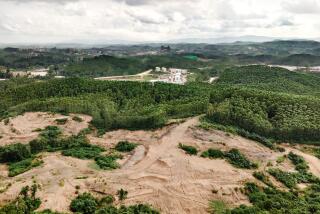Laos Capital Modernizes With an Eye on Atmosphere
- Share via
VIENTIANE, Laos — Guests at a hotel with satellite television awaken to the crowing of roosters. Fish ponds and vegetable gardens sprout behind government ministries. At cocktail time, the best show in town is the sun setting over the mighty Mekong River.
There are no high-rises--except for a revered 16th-century Buddhist temple. And the yellow stucco of French colonial villas blends with the green of palms and tamarind trees.
This is Vientiane: part village, part slowly modernizing city, the smallest and least-changed capital in Southeast Asia. Some hope it will stay this way, rather than rush after the likes of Bangkok, Manila and Singapore.
The master plan for Vientiane’s future describes the city, set in a bend of the Mekong, as “a garden,” albeit one with open sewers, dusty roads and poor garbage disposal.
“Its rural character is a phenomenon rarely available in the cities of the world today, but which has been a dream of 20th-century urban planners,” says the blueprint by the Asian Development Bank.
The plan advocates modernizing streets, electricity lines, sewerage and other infrastructure while maintaining Vientiane’s traditional character.
With Communist Laos increasingly opening its doors to the outside world, this poses a daunting challenge. Vientiane is clearly at a crossroads.
Its population, now 170,000, may mushroom to 225,000 by the end of the century. While traffic is still light by most standards, the number of cars, buses and trucks has more than quadrupled over the last decade and the number of motorcycles has soared 200-fold.
More investors are coming, along with tourists enchanted by the city’s welcoming residents and the relaxed atmosphere of a rapidly vanishing old Asia.
“It’s a race between getting laws in place and growing wealth,” said Aiden Glendinning of Ateliers de la Peninsule, a group of architects who have taken a leading conservation role.
Laotian and foreign experts fear that unplanned growth abetted by corruption, overlapping jurisdiction and decisions made by a few powerful officials without consultations may ruin efforts to retain Vientiane’s uniqueness.
The collusion of rich developers and corrupt bureaucrats in other Southeast Asian countries, including neighboring Thailand, has made jokes of such planning decrees as “no structure can be higher than a coconut tree or temple spire.”
Somsanouk Mixay, editor of the Vientiane Times and an avid conservationist, sees two prevalent views of development among Laotians.
“One eyes Bangkok. Development for them is concrete, building, skyscrapers,” he said. “But I think the majority wants to keep the old Vientiane.”
The main advocates of preservation are members of the Communist Party’s old guard, young officials educated abroad and foreigners, some of whom have renovated decaying French villas as their residences and company offices. Conservation is being increasingly stressed in the state-controlled news media, Somsanouk said.
The still nascent conservation movement is generally considered to have begun three years ago, when local opposition, backed by the Ministry of Culture, stopped Thailand’s Siam Commercial Bank from knocking down a lovely French colonial building along Lane Xane Avenue, the city’s main boulevard.
The master development plan envisions keeping buildings low-rise along that broad, tree-lined avenue and within a “heritage conservation zone” at its lower end.
Some stretches of the riverfront would be barred to traffic under the plan. And buildings in that zone would be restricted to no more than three stories and might be required to have Laotian-style sloping roofs.
Although money is still lacking, a National Heritage Project under the Culture Ministry intends to inventory all important structures in Vientiane and other towns in conjunction with planning and zoning laws.
More to Read
Sign up for Essential California
The most important California stories and recommendations in your inbox every morning.
You may occasionally receive promotional content from the Los Angeles Times.










